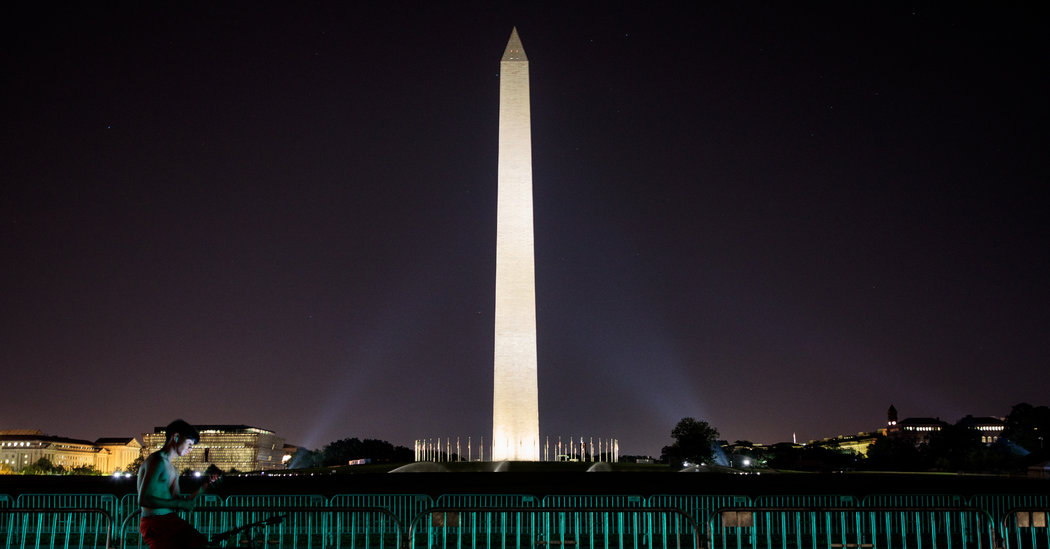Visitors to Washington can once again survey the city and gaze upon its surroundings from a beloved vantage.
After being closed for more than three years, the Washington Monument, one of the city’s most recognizable landmarks and one of the world’s tallest free-standing masonry structures at 555 feet, is set to reopen to the public on Sept. 19.
The monument had been closed since August 2016 in order to modernize its elevator system and to complete work on a security screening facility outside. The elevator’s operating system had not been updated since 1998 and was increasingly unable to accommodate the hundreds of thousands of visitors who ride up to the observation deck each year, sometimes breaking down during operating hours, leaving visitors stuck at the top or forcing them to evacuate down the structure’s nearly 900 steps.
The new operation should be a familiar, if slightly more streamlined version of what visitors have experienced in the past, according to Mike Litterst, a spokesman for the National Park Service. The new security facility, which Mr. Litterst likened to a security checkpoint at an airport with X-ray bag screeners and a magnetometer, replaces a temporary facility that had been set up at the monument since 2001.
The reopening brings cautious hope of moving beyond a troubled stretch over which the monument has been closed for repairs for more than half of the past decade.
In August 2011, the monument was rocked by a rare earthquake that struck just 84 miles from Washington, toppling visitors inside the obelisk and causing conspicuous damage including visible cracks at its pyramidal top and displaced blocks throughout. Structural repairs to the building forced its closure until May 2014, and cost around $15 million. Congress allocated half of that amount, with the remaining $7.5 donated by David M. Rubenstein, the billionaire and co-founder of the Carlyle Group, a Washington-based private equity firm.
Mr. Rubenstein, who has supported renovations to other Washington institutions, including the National Archives, the Arlington House and the National Zoo, also donated $3 million to cover the costs of the most recent round of renovations to the monument.
“It’s relatively easy to get money for medical research, which is important, and its relatively easy to get money for education,” Mr. Rubenstein said. “But if you tell somebody that a monument or a memorial is falling apart and needs to be restored, you find relatively fewer people willing to do that.”
“I guess there’s an assumption that the federal government will take care of all of that, but the government doesn’t really have the money for all this,” he said.
Securing funding has been a source of struggle since efforts began in earnest to construct the monument in 1833. Early plans envisioned a project built through private funding, from donations of no more than $1 per year from individual contributors. However by 1847, after more than a decade of fund-raising, the society organizing the project had raised only $87,000, far less than the final cost of $1,187,710 when the monument was completed in 1884. Congress eventually covered most of the remaining funding after construction stalled in 1854, famously leaving the structure standing partly finished for more than two decades.
“They wanted to make it an effort of the people,” said John Steele Gordon, the author of “Washington’s Monument: And the Fascinating History of the Obelisk.” “They just weren’t able to raise the money, and Congress realized it wasn’t going to happen and therefore they stepped in to finish it.”
The renovation was originally scheduled to be completed by this spring, but was extended to allow the National Park Service to complete a precautionary evaluation of contaminated soil surrounding the monument.
Today, the monument attracts around 500,000 visitors every year, and its limited capacity relative to larger, more spacious sites like the Lincoln Memorial can make it more difficult to access, especially during peak tourist seasons. However the panoramic views of the capital, the Potomac River and neighboring states from atop the monument, paired with its central location on the National Mall, make it one of the most sought-after sites for visitors.
Admission to the monument is free, but for the first month after its reopening, only same-day tickets will be available on a first-come-first-served basis, with around 55 guests admitted every half-hour. Park officials anticipate high demand initially and recommend that visitors arrive around an hour before ticketing begins at 8:30 a.m.
Beginning in October, admission to the monument will continue to be free to visitors arriving in person, but reservations can also be made in advance online for a $1.50 processing fee.
52 PLACES AND MUCH, MUCH MORE Follow our 52 Places traveler, Sebastian Modak, on Instagram as he travels the world, and discover more Travel coverage by following us on Twitter and Facebook. And sign up for our Travel Dispatch newsletter: Each week you’ll receive tips on traveling smarter, stories on hot destinations and access to photos from all over the world.
Source: Read Full Article


